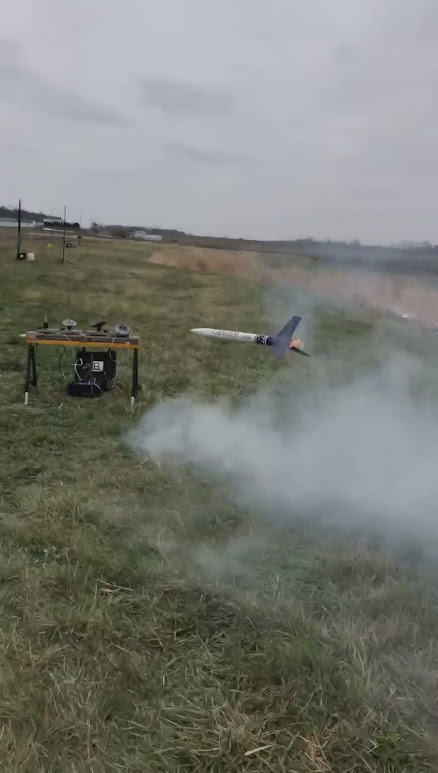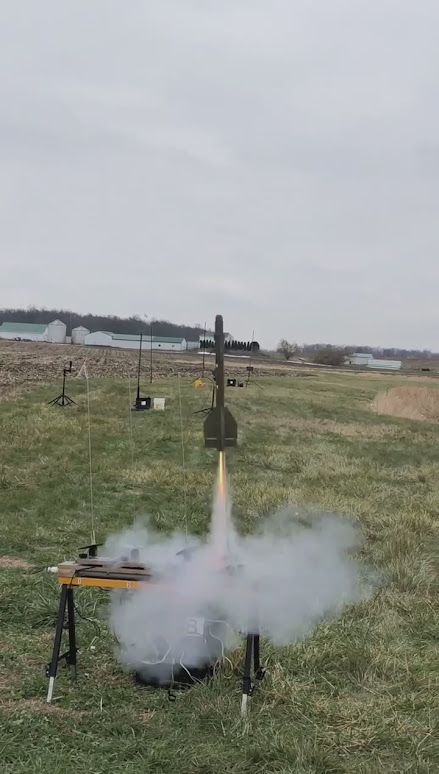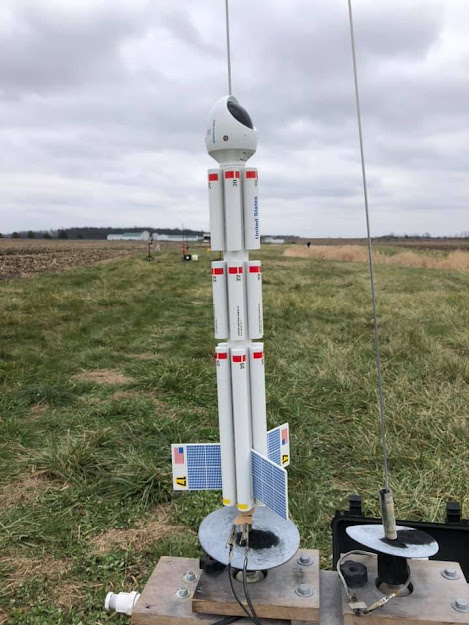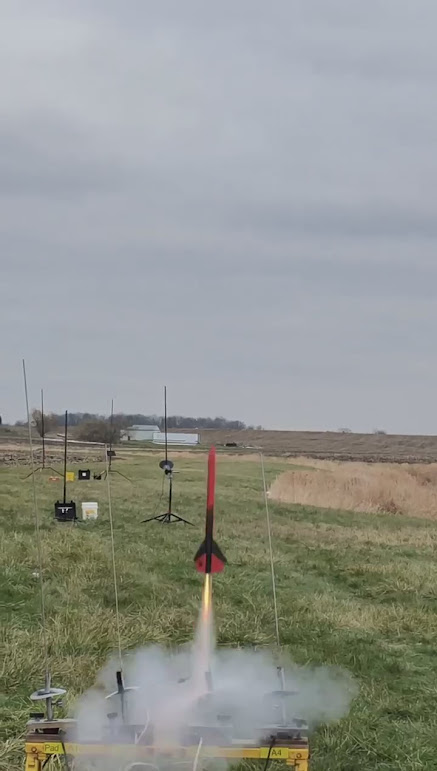Hot on the heels of what was a very nice day of flying at sunny, warm B6-4 Field came this launch with the Wright Stuff Rocketeers. Nice, but definitely not warm or sunny. I managed ten flights, several of which pegged the excitement meter and drew a laugh or two.
I'd been a busy boy, and the first flight was part of the fruits of that labor. It's a downscale of the TLP Tan Sam, or at least something close. I did the measurements off of the picture on the TLP website, so it's pretty much a guess-your-best clone.
As you can see, I opted for the rattle can camo option, which should work in my favor finding the rocket in a winter cornfield. As it turned out, I wouldn't need to worry. It was a fairly easy find.
The flight was on a D12-5 that some described as "gutless". I was concentrating on getting the launch shot, so I missed a lot of what went on after it cleared the rod. I knew fairly quickly that things were not going as hoped when I heard the sound of skywriting, and looked up in time to see the Tan Sam about to collect mission points by destroying a Ford. Guidance was off a bit and instead of a massive kaboom the Tan Sam dropped to the ground, hopped onto Loopy's rocket totes and barfed all over them. Stunned silence for just a moment, then the whole crowd erupted in laughter. I couldn't have brought that much joy if I told the monkey joke. It was going to be a tough flight to follow.
Hold my beer, said the SLS Wizard.
The Wizard started out life as an Estes Executioner, but for some reason that design held little appeal to me. (I think the fins are still laying around somewhere downstairs.) A Wizard upscale, on the other hand, was like my childhood on steroids. The big nasty kind that give you zits and back hair. Yeah, that's the ticket.
E12-6 flight. Well, "flight". I think this one is best told via the pics.
There was actually movement before the E12 detonated, but not much. The motor casing blew back up into the motor tube, and the engine block is effectively gone. Most of the actual motor tube is burned away past where the engine block once was. The nose cone never actually ejected, which leads me to believe that the bulk of the ejection charge spent itself out the back of the rocket. Some of the clay was found inside the body tube when I took the nose cone off to check the parachute. It's in excellent shape, no burns or scorching.
To my credit, the idea of packing up and going home didn't occur to me. I'm stupid that way. Instead, I picked a design of my own, the FRW Bulldog Low, to be my next flight. This one would be a D12-5 that I bought at the same time as the one in the Tan Sam. Gulp.
Not to worry. This one was a tested flight vet and flew as expected. Not a hint of a problem, except that it would be my first trip across the creek. Well, through the creek. Turns out my Timberlands are actually waterproof.
Another TLP flight would be next, this time the Dragonfly, an actual TLP kit. This would be another flight powered by one of the D12-5s that I picked up a few days earlier at Hobby Lobby.
Since the previous flight had recovered in the cornfield on the other side of the creek, I moved a rod to send the Dragonfly up more to the left.
Changing the rod angle worked. This flight arced to the left ever so slightly, then kept going left after it tipped. At ejection it began racing behind the flight line and over near the field entrance. A long walk with a muddy finish. When I arrived at the spot in the corn where it all came to an end, I found the rocket in four pieces, three of which were found. Should be a fairly simple fix and the missing piece won't be terribly noticeable after a touchup.
Okay, speaking of "hold my beer", my next flight would be a clone of the FSI Echo-1 on a C11-0/C11-7 combination. Yeah, I saw you flinch when I said that. This rocket hadn't flown since a C11-0/C11-7 incident back in 2013. That one featured an immediate CATO of the C11-0 which then lit the C11-7, which continued the flight successfully.
Again, the photos tell much of the story, but I'll try to narrate a bit.
Barely any movement before the C11-0 cried HAPPY NEW YEAR!!! The C11-7 was fooled into an early ignition, and may have made it as far as 20 feet before popping the cork itself. At that point we had three parts to watch. I tried to follow all of them at the same time.
I scanned the skies and found the sustainer clawing its way skyward. Unfortunately it had been declawed. It tipped over and planted itself into the mud of the cornfield to our left. I never got a picture of that particular cornflower, but whipped around to see the nose cone and parachute recovering on the opposite side of the creek to our right. Right about then I was going to ask if anyone had tracked the booster, but it was pointed out to me before I could ask.
As Jackie Gleason would say "Oof." So now I have a question. Do I count the booster or sustainer when figuring out altitude? An average of the two? Yeah, oof.
My next flight would again be multiple engines, but in this case two C6-5s side by side.
This is a great setup. I can fly it in the corn for a smoky, noisy flight on the Cs, and fly it at B6-4 Field on two As without overflying the field provided the weather is calm.
Unlike the previous two flights, this one headed right in a big way. The flight was deep into the corn on the opposite side of the creek. It ejected as it was tipping over, then barely made a dent in the distance on the trip back. I had a nice swim across the creek and picked up 40 pounds of mud on my boots before I made it back to the flightline.
Flight #7 was another reliable flyer, the Estes Explorer Aquarius that I built like a tank several years back. Chas Russell gifted this to me at a NARCON longer ago than either of us wants to think.
I did a lot of reinforcing on this one, so it's fairly piggish, but as a D12 bird it's about perfect. It can take the abuse of rough landings, which a lot of these that I see fly can't do. It also has enough Kevlar and elastic that the odds of it bouncing back and leaving an Estes dent are effectively nil.
Flight was to the left off the pad to 513' 24" with recovery as it was facing down and a slow, swinging recovery into the cornfield. Somewhat muddy, but rock solid as ever.
My second FSI clone of the day would be flight #8, the Maverick on an E12-6.
Unlike the previous FSI and E12 flights, this one was letter perfect. It was angled to the left and was never in danger of crossing the creek. It actually appeared to pierce the cloud deck and we lost sight of it for a while before the neon orange chute was spotted. It crossed the field to our left and landed in the same general spot as the TLP Dragonfly, in the mud near the field entrance.
This one had it all, great altitude, successful recovery, no damage. My next launch wasn't so lucky.
Unlucky flight #9 was the Centuri Tiger Streak that I cloned in 2013 for the NARAM outside of Akron. That flight was a lucky recovery as it landed in the middle of a yard across the street from the field and dodged wires, a house, trees and a pool for a successful flight.
That flight had been on a B6-0/B6-6 combo, but the larger expanses of the Cedarville cornfield demanded bigger air, hence the C6-0/B6-6 load. I really thought this was a good idea. The pad was angled to the left, which made no difference at all.
There was no left to the flight, rather straight and angling toward the high power pads. It was the same path as my Astron Farside took back in the spring. Maybe they'll chat. Maybe they'll remember me. The Tiger Streak butt was pointing at the flightline when it staged. The booster recovered across the creek. The sustainer kept heading straight out from the pad until we lost site of it. I walked the field, scanning the corn on each side of of the path for the pink and white parachute or the orange body tube, but saw nothing. The corn wasn't friendly to multi stagers on this particular day.
After that flight I almost packed up and went home, but instead decided that since I still had rockets prepped, I should at least go for double figures. Flight #10 would be the Satellite Interceptor cluster, a rocket that hadn't flown since 2008.
Originally an Estes S.W.A.T., I never warmed to the faux-camo paint scheme and couldn't imagine flying it on a single 18mm motor. Instead I built it as intended, but with a 3x18mm motor mount and the paint scheme of the Satellite Interceptor, (white, woo-hoo!) then printed off a set of upscale decals.
I don't know if anyone can say they are confident when flying a 3x18mm cluster, but I had high hopes that the flight would be successful when I got all the clips hooked up and they stayed that way. Impressive. The last time this rocket flew, in fact, the only time, it only lit two of the three motors and the flight was completely successful. I was hoping to go 3 for 3 on this one and I got them all. The flight was straight and stable all the way, topping out just below the cloud deck and swinging down to a recovery 100' deep in the cornfield. I stopped to watch a couple of other flights, but my boots clotted with 72# of mud and the mildly hypothermic feel to my face told me that my day was over. I'd done all the damage I cared to do.
































































